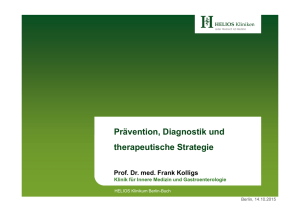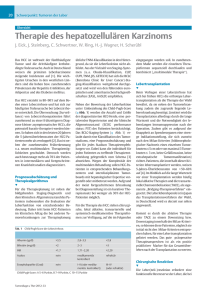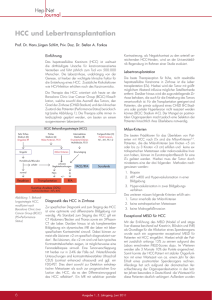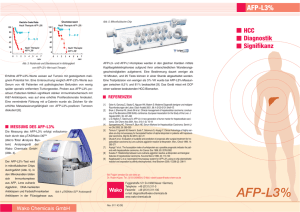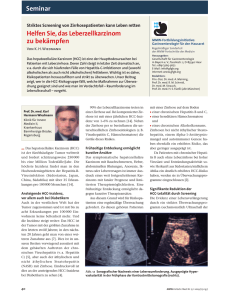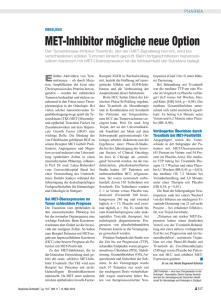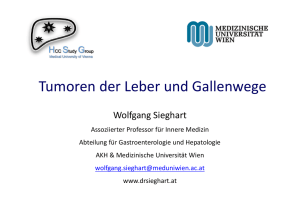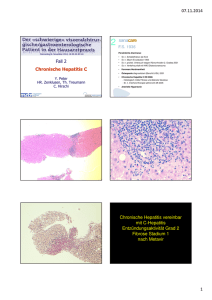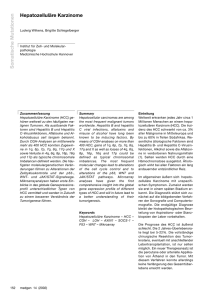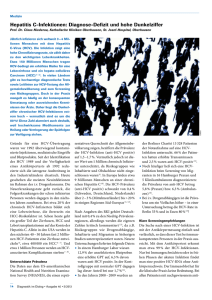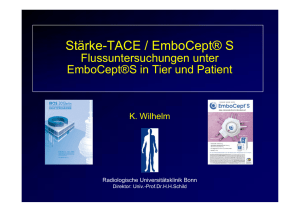PowerPoint-Präsentation - Medizinische Hochschule Hannover
Werbung
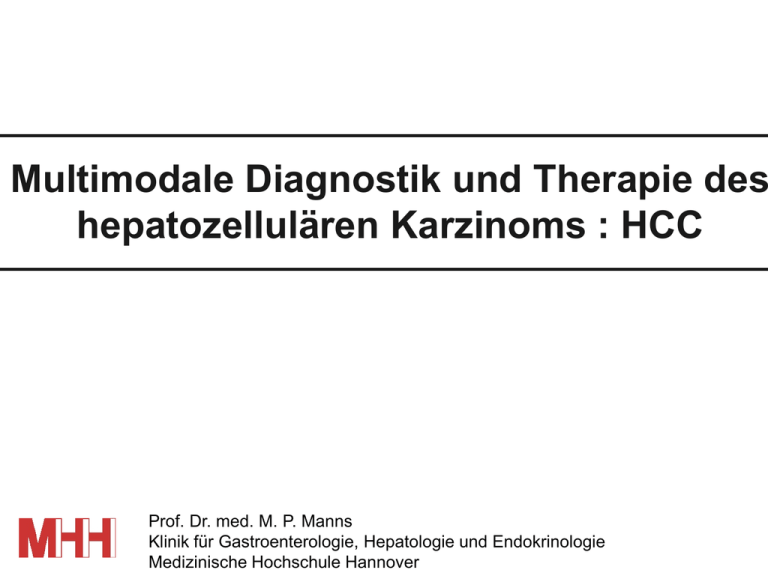
Multimodale Diagnostik und Therapie des hepatozellulären Karzinoms : HCC Prof. Dr. med. M. P. Manns Klinik für Gastroenterologie, Hepatologie und Endokrinologie Medizinische Hochschule Hannover HCC: Multimodal und Interdisziplinär • Klinik für Gastroenterologie, Hepatologie und Endokrinologie • Klinik für Allgemein-, Viszeral- und Transplantationschirurgie • Klinik für Haematologie, Haemostaseologie, int. Onkologie und Stammzelltransplantation • Institut für diagnostische Radiologie • Klinik für Strahlentherapie DFG-KliFo 119: „Molekular Basis and Therapeutic Concepts in HCC“ Chair: M.P. Manns; Director: S. Kubicka Institut für Pathologie Prof. Dr. H. Kreipe Dr. P. Flemming PD Dr. U.Lehmann Institut für Molekularbiologie Prof. Dr. A. Gossler Dr. N. Malek Klinik für Gastroenterologie, Hepatologie u. Endokrinologie Prof. Dr. M. Manns Prof. Dr. S. Kubicka Prof. Dr. C. Strassburg Prof. Dr. L. Rudolph(Ulm) PD. Dr. N. Malek Prof. Dr. T. Greten Dr. A. Vogel Institut für Zell- und Molekularpathologie Prof. Dr. B.Schlegelberger PD Dr. L. Wilkens GBF Braunschweig PD Dr. J. Bruder Abt. Hämatologie/Onkologie (assoziiert) Prof. Dr. A. Ganser Dr. V. Grünwald Maligne Lebertumore Metastasen Lebereigene Karzinome • Hepatozelluläres Karzinom • Cholangiokarzinom Weltweite Inzidenz des HCC im Jahr 2000 Alters angepasste Inzidenz / 100.000 Männer 80s' 90s' USA 2,3 7,0 7,5 France 10,2 4,8 Italy 10,9 19,0 Japan Death rate per 100,000 40,0 H. El Serag et al. NEJM 1999 Kiyosawa K, Jpn J Inf Dis 2002 Zunahme des HCC in Deutschland Prof. Dr. med. M. P. Manns Klinik für Gastroenterologie, Hepatologie und Endokrinologie Medizinische Hochschule Hannover Häufigste Krebssterbefälle in Niedersachsen (2001) 2,7 Le ber Leber Mund und Rach e Mund und Rachen 3,3 Le ukä mie Leukämie 3,3 Spe iserö hre Ösophagus 3,6 Harnb lase Harnblase 3,6 Niere Niere 3,7 5,3 Bau Pankreas chs peichel drüse 5,8 Mage n Magen 11,5 Pros tata Prostata 12,5 Darm Darm 25,4 Lu nge Lunge 0 0 55 10 10 15 15 20 20 25 25 30 30 Epidemiologisches Krebsregister Niedersachsen, Dezember 2004 Zunahme der HCC Sterblichkeit 36 HCC 11 Liver cirrhosis 34 10 32 9 30 8 28 7 26 6 24 5 81 83 85 87 89 91 93 95 22 Year Prof. Dr. med. M. P. Manns Abteilung Gastroenterologie, Hepatologie und Endokrinologie Medizinische Hochschule Hannover Sterblichkeitsrate pro 100.000 [Leberzirrhose] Sterblichkeitsrate pro 100.000 [HCC] 12 Häufigkeiten der Hauptkomplikationen bei initial kompensierter HCV-Zirrhose 16 HCC Aszites 7 3 Ikterus 2,5 Blutende Varizen 0,4 Enzephalopathie 0 5 10 15 20 % aller ersten Komplikationen Benvegnù et al, 2000 Prof. Dr. med. M. P. Manns Abteilung Gastroenterologie, Hepatologie und Endokrinologie Medizinische Hochschule Hannover Wandel der Komplikationen der Leberzirrhose , 90er , 90er Wandel der Komplikationen der Leberzirrhose , , 90er 2006 80er Risikofaktoren für die Entstehung eines HCC chronische HBV + HCV Infektion Alkohol Aflatoxine Hämochromatose Übergewicht/Diabetes (NASH) Leberzirrhose Kumulative HCC Inzidenz (%) HCC Incidence [%] Cumulative HBe-Ag Serokonversion and HCC 12 HBsAg+ HBeAg+ 10 8 6 4 HBsAg+, HBeAg— 2 HBsAg—, HBeAg— 0 0 1 2 3 4 5 6 Jahre Jahre Years 7 8 9 10 Yang HI, et al. N Engl J Med 2002 Cumulative Incidence of HCC [%] Risk of HCC across a Biological Gradient of Serum HBV Virus DNA Level Baseline HBV DNA Level copies/mL 14 ≥ 1 Mio 12 10 100 000 - 999 999 8 6 4 10 000 - 99 999 2 300 - 9 999 < 300 0 Year of Follow Up Chen et al. JAMA 2006 Nucleosid Treatment reduces the risk of HCC in patients with chronic HBV infection Liaw NEJM 2004 HCV-Prävalenz in Deutschland (Bundes-Gesundheitssurvey 1997-1998) • Bevölkerungsstichprobe (18-79 J.) n = 6.748 • Durchseuchung (anti-HCV) 0,4% • Virusträger (HCV-PCR positiv) 84% • Ausschluss von Personen aus - Krankenhäusern, Pflegeheimen etc. - Justizvollzugsanstalten • iv Drogenkonsumenten unterrepräsentiert Schätzung 400.000 - 500.000 Virusträger Palitzsch et al. 1999 Anzahl der HCC Sterbefälle Anteil der viralen Hepatitis am HCC 8.000 7.000 keine Lebererkrankung andere Lebererkrankung Virale Hepatitis alkoholische Lebererkrankung 6.000 5.000 4.000 3.000 2.000 1.000 1980 1982 1984 1986 1988 1990 1992 1994 1996 1998 Gastroenterology (2005) 129 486 Carcinogenesis rate Cumulatives Risiko bei HCV induzierter Zirrhose am Beispiel von 183 Patienten mit HCV induzierter Leberzirrhose Ikeda J Hepatol 2006 Risikofaktoren für die Entstehung eines HCC bei chronischer HCV Infektion und Leberzirrhose AFP > 20 ng/ml Männliches Geschlecht Alter > 55 Jahre 3 Thrombopenie < 100.000 Tsd./mm Ikeda J Hepatol 2006 HCC - Ursachen (MHH 1998 - 2003, 396 Patienten) Other 8 % toxic 41 % HBV + HCV 3 % HBV 21 % HCV 28 % Greten et al Br J Can 2005 HCC-Inzidenz bei Kindern in Taiwan: Hepatitis B-Impfung verhindert Leberkrebs! 0,8 [rate per 100,000] Incidence of HCC 0,9 0,7 0,6 0,5 0,4 0,3 0,2 0,1 0 1981 1983 1985 1987 1989 1991 1993 Chang et al, NEJM 1997 % der Kinder mit vorliegendem Impfausweis Anteil gegen Hepatitis B geimpfter Kinder bei Einschulung, 1996-2003 (Stand: September 2004) 90 81 80 71 70 60 completed vollständig begun begonnen 57 50 45 40 30 26 20 10 15 14 8 11 7 5 0 1996 1997-99 2000 2001 2002 2003 Quelle: RKI Möglichkeiten der HCC Prävention Greten, Wedemeyer, Manns Deutsches Ärzteblatt 2006 Risikofaktoren für die Entstehung eines HCC chronische HBV + HCV Infektion Alkohol Aflatoxine Hämochromatose Übergewicht/Diabetes (NASH) Leberzirrhose Kumulative Inzidenz für ein HCC [%] Geschätztes HCC Risiko 30 20 HCV HBV 10 Alkohol 0 0 1 2 Jahre 3 4 5 Greten, Wedemeyer, Manns Deutsches Ärzteblatt in press Prof. Dr. med. M. P. Manns Abteilung Gastroenterologie, Hepatologie und Endokrinologie Medizinische Hochschule Hannover Kumulative Inzidenz für ein HCC [%] Geschätztes HCC Risiko 30 HCV + Alkohol 20 HCV HBV 10 Alkohol 0 0 1 2 Jahre 3 4 5 Greten, Wedemeyer, Manns Deutsches Ärzteblatt in press Prof. Dr. med. M. P. Manns Abteilung Gastroenterologie, Hepatologie und Endokrinologie Medizinische Hochschule Hannover HCC Risikofaktoren Gesamtbevölkerung HBV HCV Alkohol Diabetes Hepatozelluläres Karzinom USA 16 % 22 % 32 % Italien 22 % 36 % 45 % 20 % Morgan Gastroenterology 2004 Prof. Dr. med. M. P. Manns Abteilung Gastroenterologie, Hepatologie und Endokrinologie Medizinische Hochschule Hannover Risikofaktoren für die Entstehung eines HCC chronische HBV + HCV Infektion Alkohol Aflatoxine Hämochromatose Übergewicht/Diabetes (NASH) Leberzirrhose Karzinomrisko für Männer mit einem BMI ≥ 35 kg/m2 Calle NEJM 2003 Cumulative Incidence Diabetes und HCC Chronic non-alcoholic liver diseases HCC Diabetes Diabetes No Diabetes No Diabetes Follow up (Years) El-Serag Gastroenterology 2004 Prof. Dr. med. M. P. Manns Abteilung Gastroenterologie, Hepatologie und Endokrinologie Medizinische Hochschule Hannover NASH: Natürlicher Verlauf NAFLD – „pur fat“ 10% / 10 Jahre Volkskrankheit NASH NASH Steatosis: 10% / 10 Jahre Ca. 20.000.000 Menschen in Deutschland! Leberzirrhose 10%-20% / 10 Jahre HCC Risikofaktoren Europa + US Japan Afrika + Asien HBV 22 (4-58) 20 (18-44) 60 (40-90) HCV 60 (12-72) 63 (48-94) 20 (9-56) Alkohol 45 (8-57) 2 (15-33) 0 (11-41) Nikotin 12 (0-14) 40 (9-51) 22) Kontrazeptiva 0 (10-50) - 8 kaum kaum häufig <5 - <5 Aflatoxine andere Bosch Gastroenterology 2004 Risikofaktoren für ein HCC Leberzirrhose HBV HCV Hämochromatose PBC / PSC / M. Wilson AIH BMI ≥ 35 kg/m2 Alkohol Rauchen Aflatoxin ohne mit +++ ++ +++ +++ +++ + ++ + ++ + +++ Prof. Dr. med. M. P. Manns Abteilung Gastroenterologie, Hepatologie und Endokrinologie Medizinische Hochschule Hannover Coffee consumption reduces the risk of HCC independently of its etiology J. Hepatol. (2005) 42: 528 Influence of Coffee Drinking on Subsequent Risk of HCC: A prospective study in Japan J. Natl. Cancer Inst. (2005) 97:293 Coffee consumption reduces the risk of HCC independently of its etiology J. Hepatol. (2005) 42: 528 Influence of Coffee Drinking on Subsequent Risk of HCC: A prospective study in Japan J. Natl. Cancer Inst. (2005) 97:293 Mass on surveillance ultrasound in a cirrhotic liver < 1 cm Repeated US at 3-4 months intervals Stable over 1824 months Enlarging Return to standard surveillance protocol (6-12 monthly) Proceed according to lesion size Mass on surveillance ultrasound in a cirrhotic liver < 1 cm 1 - 2 cm Repeated US at 3-4 months intervals Two dynamic imaging studies Coincidental typical vascular pattern on dynamic imaging Stable over 1824 months Typical vascular pattern with one technique Atypical vascular pattern with both techniques Biopsy Enlarging Diagnostic of HCC Non diagnostic Return to standard surveillance protocol (6-12 monthly) Proceed according to lesion size Treat as hepatocellular carcinoma Other diagnosis Mass on surveillance ultrasound in a cirrhotic liver < 1 cm 1 - 2 cm Repeated US at 3-4 months intervals Two dynamic imaging studies Coincidental typical vascular pattern on dynamic imaging Stable over 1824 months Typical vascular pattern with one technique Atypical vascular pattern with both techniques Biopsy Enlarging Diagnostic of HCC Non diagnostic Repeat biopsy or Imaging follow-up Return to standard surveillance protocol (6-12 monthly) Proceed according to lesion size Other diagnosis Change in size/profile Repeat imaging and/or biopsy Positive Treat as hepatocellular carcinoma Negative Mass on surveillance ultrasound in a cirrhotic liver < 1 cm 1 - 2 cm Repeated US at 3-4 months intervals Two dynamic imaging studies Coincidental typical vascular pattern on dynamic imaging Stable over 1824 months > 2 cm Typical vascular pattern with one technique One dynamic imaging studies Atypical vascular pattern with both techniques Atypical vascular pattern Typical vascular pattern on dynamic Imaging or AFP > 200 ng/ml Biopsy Enlarging Diagnostic of HCC Non diagnostic Repeat biopsy or Imaging follow-up Return to standard surveillance protocol (6-12 monthly) Proceed according to lesion size Other diagnosis Change in size/profile Repeat imaging and/or biopsy Positive Treat as hepatocellular carcinoma Negative Molek./ immunol. Therapie Lokale Therapie Chirirugie Therapie des HCC Supportive Therapie Strahlentherapie Chemo therapie Therapiealgorithmus HCC PST 0, Child-Pugh A PST 0-2, Child-Pugh A-B PST >2, Child-Pugh C Very Early Stage Early Stage Intermediate Stage (B) Advanced Stage Single ≤ 2 cm Single or 3 nodules ≤ 3cm, PS 0 Multinodular, PS 0 Portal invasion, N1,M1, PS 1-2 Terminal Stage 3 nodules ≤3 cm Single PVP / bilirubin Increased Normal No Resektion Portal invasion, N1,M1 Associated disease LTx (CLT/LDLT) Yes PEI / RF Curativer Treatment No TACE Yes new Agents RCT BSC AASLD Guidelines 2005 Liver resection versus transplantation for hepatocellular carcinoma in cirrhotic patients Bismuth et al., Ann Surg. 218:145-51, 1993 All Resection Transplantation 1-2 Nodules < 3cm Resection Transplantation 3 y OS 3 y RFS 50% 47% 27% 46% p<0.05 18% 83% p<0.001 LTX ist gerade für kleine HCCs in fortgeschrittener Leberzirrhose günstiger als die Resektion, da die „prämaligne Leberzirrhose“ durch die LTX entfernt wird Liver transplantation: first series of cirrhotic patients with HCC Authors N Tumor stage Rec 3y 5y Ringe et al. 1991 61 80% > 5cm - 15% 15% Iwatsuki et al 1991 105 35% portal invasion 75% multinodular 43% 39% 38% Bismuth et al. 1993 60 50% symptomatic 50% > 3 nodules 54% 49% - Moreno et al. 1995 25% portal invasion 60% T4 32% 67% 48% 38 Liver transplantation for HCC: outcomes applying restrictive selection criteria Authors N Selection criteria Rec 5y OS 48 Single < 5cm 3 nodules < 3cm 8% 74%* Bismuth Sem Liv. Dis 45 single < 3cm 3 nodules < 3cm 11 % 74% Llovet et al. Hepatology 1999 79 single < 5cm 4% 75% 16 % 71 % 120 single < 5cm 3 nodules < 3cm Mazzaferro et al. NEJM 1996 Jonas et al Hepatology 2001 * 4y OS HCC Tumorstadien: Indikation für eine Lebertransplantation (Milan-Kriterien) Keine Fern- oder Lymphknotenmetastasen 3 Tumorknoten mit jeweils 3 cm Durchmesser 1 Tumorknoten 5cm Durchmesser Keine Infiltration in Gefäße Therapiealgorithmus HCC PST 0, Child-Pugh A PST 0-2, Child-Pugh A-B PST >2, Child-Pugh C Very Early Stage Early Stage Intermediate Stage (B) Advanced Stage Single ≤ 2 cm Single or 3 nodules ≤ 3cm, PS 0 Multinodular, PS 0 Portal invasion, N1,M1, PS 1-2 Terminal Stage 3 nodules ≤3 cm Single PVP / bilirubin Increased Normal No Resektion Portal invasion, N1,M1 Associated disease LTx (CLT/LDLT) Yes PEI / RF Curativer Treatment No TACE Yes new Agents RCT BSC AASLD Guidelines 2005 Perkutane Ethanol Injektion Perkutane Ethanol Installation als lokoregionales Therapieverfahren PEI- Applikation Radiofrequenzthermoablation Transkutane Therapie des HCC RFA oder PEI? HCC-Stadien in den Studien: Single HCC ≤5cm oder 3 HCC ≤3cm, keine Gefäßinvasion, 1cm Abstand vom Hilus und Gallenblase, Child A und B, Thrombozyten >50.000, Quick>50%, nicht operable, keine Vortherapie oder HCC ≤ 4cm, Tumoranzahl <3, Child A und B, keine Vortherapie, >5mm Abstand zum Hilus und DHC Rate der 2-Jahres-Lokalrezidive: PEI 11-45% versus RFA 2-18% Anzahl der Therapien bis zu kompletten Ansprechen RFA < PEI Nebenwirkungsprofil RFA < PEI Eine Studie mit besserer 5-Jahresüberlebensrate durch RFA Lin et al, Gut 2005; Shiina et al, Gastroenterology 2005; Lin et al, Gastroenterology 2005; Lencioni Radiology 2003 Transarterielle Chemoembolisation Leberarterien Leber Tumor Art.hepatica T. coeliacus Aorta Art. iliaca Katheter Embolisat / Chemotherapiegemisch Chemoembolisation oder Embolisation vs. Supportive Care des nicht-resezierbaren HCC* Studie Anzahl der Patienten Lin et al., 1998 63 GETCH., 1995 96 Bruix et al., 1998 80 Pelletier et al., 1998 73 Lo et al., 2002 79 Llovet et al., 2002 112 Gesamt 503 Odds ratio (95% CI); Random Effects Model p=0.017 0.01 0.1 0.5 1 Behandlungsbenefit 2 10 100 Benefit Kontrolle Remissionsraten in den Studien ca. 30 bis 40 % *Metaanalyse von RTCs Modifiziert nach Llovet JM, et al. Lancet 2003;362:1907–17 TACE: Kontraindikationen • • • • • • • • • extrahepatisch metastasiertes HCC schlechte Leberfunktion (CHE < 3,0) Ejektionsfraktion < 50 % (Doxorubicin) eingeschränkte Nierenfunktion (Cisplatin) CHILD C Portalvenenthrombose Aszites, ausgeprägte port. Hypertension Gefäßinvasion des HCC Tumormasse > 50% der Leber Chemotherapiespiegel Drug eluting Beads Überlebensanalyse von 389 Patienten mit HCC an der MHH 100 Resektion TACE + PEI 50 PEI TACE BSC 0 0 1 2 3 4 5 6 Greten et al Br. J Cancer 2005 Durchgeführte Therapien an 389 Patienten OP 6 % BSC 50 % PEI 18 % TACE 13 % TACE + PEI 13 % Greten et al Br. J Cancer 2005 Therapiealgorithmus HCC PST 0, Child-Pugh A PST 0-2, Child-Pugh A-B PST >2, Child-Pugh C Very Early Stage Early Stage Intermediate Stage (B) Advanced Stage Single ≤ 2 cm Single or 3 nodules ≤ 3cm, PS 0 Multinodular, PS 0 Portal invasion, N1,M1, PS 1-2 Terminal Stage 3 nodules ≤3 cm Single PVP / bilirubin Increased Normal No Resektion Portal invasion, N1,M1 Associated disease LTx (CLT/LDLT) Yes PEI / RF Curativer Treatment No TACE Yes new Agents RCT BSC AASLD Guidelines 2005 El Serag and Rudolph, Gastroenterology 2007 HCC - molekulare Therapie 2005-2007 Autor Protokoll N RR PFS/TTP PFS @6M MS Gefitinib Lapatinib Erlotinib Cetuximab GemOx+Cetux 31 37 38 27 37 3,2 5% 9% 0 24% 2,3 2,3 3,2 2,0 4,5 NA NA 32% 22,2% 40% NA 6,2 13 NA 9,2 TSU-68 Bevacizumab Bevacizumab GemOx-Beva CapOx+Beva 15 30 24 33 30 6% 10% 12,5 20% 13,3 NA 6,5 3,5 5,3 4,5 NA NA 17% 48% 45% NA NA NA 9,6 10,6 Sorafenib Sorafenib Sunitinib Sunitinib 137 299* 26 37 5% 2,3 3,8 2,7 5,6 5,5 4,1 5,2 37% NA 35% 35% 9,5 10,7 11,6 11,2 29 20,6 8,8 NA 19 Anti-EGFR O´Dwyer 06 Ramanathan 06 Philip 05 Grünwald 07 Louafi 07 Antiangiogenese Kanai 06 Schwatz 06 Malka 07 Zhu 06 Sun 07 Multikinase-I Abou-Alfa 04 Llovet 07 Zhu 07 Faiver 07 Multi-target Ansatz Thomas 07 Erlotinib+Beva Sorafenib: B-RAF und VEGFR-Inhibitor Tumorzelle Endothelzelle, Perizyten Sorafenib Sorafenib Sorafenib antiproliferativ antiangiogenetisch Wilhelm S et al. Clin Cancer Res. 2003;9(suppl). Abstract A78. Phase III SHARP Studie: Gesamtüberleben (Intention-to-treat) Überlebenswahrscheinlichkeit 1.00 Sorafenib Median: 46,3 Wochen (10,7 Monate) (95% CI: 40,9–57,9) 0.75 Placebo Median: 34,4 Wochen (7,9 Monate) (95% CI: 29,4–39,4) 0.50 0.25 Hazard ratio (S/P): 0.69 (95% CI: 0.55–0.88) p=0.00058* 0 Patientenanzahl 0 Sorafenib: 299 Placebo: 303 8 16 24 32 40 48 56 64 72 274 276 241 224 205 179 161 126 108 78 67 47 38 25 12 7 0 2 80 Wochen 0 0 *O’Brien–Fleming-Grenzwert für statistische Signifikanz war p=0.0077 Llovet JM, et al., ASCO 2007, Chicago, IL, USA Hand Foot Skin Reaction Stadien - adaptierte Therapie des HCC PST 0, Child A, Okuda 1 PST 0-2 Child A-B Okuda 1-2 PST 2 Child C Okuda 3 very early stage early stage intermediate advanced terminal Single<2cm Carcinoma in situ Performance (PST) 0 single ≤ 5cm or ≤ 3 nodules ≤3cm PST 0 >3 nodules single >5cm PST 0 portal invasion N1 / M1, PST 1-2 stage D Normal portal pressure Liver function : CHE >3, Normal Bilirubin Yes No Associated disease No Resection LTX Yes RFA/PEI Portal invasion or N1 or M1 No Chemoembo Yes Sorafenib (Child A) Symptomatic treatment or new agents Sorafenib für Patienten mit HCC Pro Erste Phase III Studie die eine signifikante Verlängerung des Überlebens durch eine systemische Therapie zeigt 44%-ige Verbesserung des Überlebens Relativ gute Verträglichkeit bei Patienten mit HCC und Child A Contra Selektiertes Patientenkollektiv: Europäer, Child A „Nur“ 2,7 Monate absolute Verlängerung des mittleren Überlebens Zeit bis zur symptomatischen Tumorprogression nicht verändert Einfluss auf die Lebensqualität bleibt unklar („clinical benefit?“) Kosten: ca. 4500,- € pro Monat Klinisch-experimentelle Ansätze an der MHH • Identifikation von small molecules: • Phase II Studie zur Therapie mit Cetuximab (Erbitux) • Testung von „drug-eluting“ Beads zur TACE • Immuntherapeutische Ansätze: BMBF BIOPHARMA •Peptidvakzination • Depletion von regulatorischen T-Zellen Helmholtz Alliance “Immunotherapies against Cancer” Tumor CD8 CD4 C T L tumor dendritische Zelle Greten et al. Design einer Tumorvakzine zur spezifischen Stimulation des eigenen Immunsystems gegen den Tumor Stadien - adaptierte Therapie des HCC PST 0, Child A, Okuda 1 PST 0-2 Child A-B Okuda 1-2 SIRT very early stage early stage intermediate Single<2cm single ≤ 5cm or Carcinoma in situ ≤ 3 nodules ≤3cm >3 nodules single >5cm Normal portal pressure Liver function : CHE >3, Normal Bilirubin Yes No advanced terminal portal invasion stage D N1 / M1 Radiation Associated disease Child A No Resection PST 2 Child C Okuda 3 LTX Child B/C Yes RFA/PEI Chemoembo Sorafenib Symptomatic treatment or new agents
